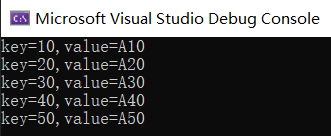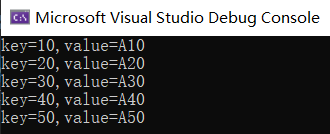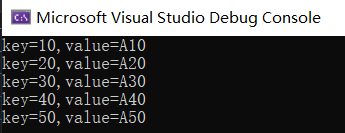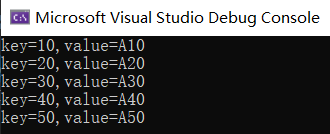遍歷 Dictionary,你會幾種方式?
一:背景
1. 講故事
昨天在 StackOverflow 上看到一個很有趣的問題,說: 你會幾種遍歷字典的方式,然后跟帖就是各種奇葩的回答,挺有意思,馬上就要國慶了,娛樂娛樂吧,說說這種挺無聊的問題。
二: 使用 foreach 遍歷
為了方便演示,先上一段測試代碼:
- var dict = new Dictionary<int, string>()
- { [10] = "A10",
- [20] = "A20",
- [30] = "A30",
- [40] = "A40",
- [50] = "A50"
- };
1. 直接 foreach dict
如果要拿百分比說話,估計有 50%+ 的小伙伴用這種方式,為啥,簡單粗暴唄,其他沒什么好說的,直接上代碼:
- foreach (var item in dict)
- { Console.WriteLine($"key={item.Key},value={item.Value}");
- }

這里的 item 是底層在 MoveNext 的過程中用 KeyValuePair 包裝出來的,如果你不信的話,看下源碼唄:
- public bool MoveNext()
- { while ((uint)_index < (uint)_dictionary._count)
- { ref Entry reference = ref _dictionary._entries[_index++];
- if (reference.next >= -1)
- { _current = new KeyValuePair<TKey, TValue>(reference.key, reference.value);
- return true;
- } } }
2. foreach 中 使用 KeyPairValue 解構
剛才你也看到了 item 是 KeyValuePair 類型,不過的是 netcore 對 KeyValuePair 進行了增強,增加了 Deconstruct 函數用來解構 KeyValuePair,代碼如下:
- public readonly struct KeyValuePair<TKey, TValue>
- { private readonly TKey key;
- private readonly TValue value;
- public TKey Key => key;
- public TValue Value => value;
- public KeyValuePair(TKey key, TValue value)
- { this.key = key;
- this.value = value;
- } public void Deconstruct(out TKey key, out TValue value)
- { key = Key; value = Value;
- } }
有了這個解構函數,你就可以在遍歷的過程中直接拿到 key,value,而不是包裝的 KeyValuePair,這在 netframework 中可是不行的哈,實現代碼如下:
- foreach ((int key, string value) in dict)
- { Console.WriteLine($"key={key},value={value}");
- }

3. foreach keys
前面的例子都是直接對 dict 進行 foreach,其實你還可以對 dict.keys 進行 foreach 遍歷,然后通過遍歷出的 key 對 dict 進行類索引器讀取,代碼如下:
- foreach (var key in dict.Keys)
- { Console.WriteLine($"key={key},value={dict[key]}");
- }

說到這里,不知道你是否有一個潛意識,那就是 dict 只能通過 foreach 進行遍歷,真相是不是這樣的呢? 要尋找答案,還是回頭看一下 foreach 是如何進行遍歷的。
- public struct Enumerator : IEnumerator<KeyValuePair<TKey, TValue>>, IDisposable, IEnumerator, IDictionaryEnumerator
- { public bool MoveNext()
- { while ((uint)_index < (uint)_dictionary._count)
- { ref Entry reference = ref _dictionary._entries[_index++];
- if (reference.next >= -1)
- { _current = new KeyValuePair<TKey, TValue>(reference.key, reference.value);
- return true;
- } } _index = _dictionary._count + 1;
- _current = default(KeyValuePair<TKey, TValue>);
- return false;
- }}
仔細看這個 while 循環,你就應該明白,本質上它也是對 entries 數組進行遍歷,那底層都用了 while,我是不是可以用 for 來替換然后循環 dict 呢?哈哈,反正就是模仿唄。
三:使用 for 遍歷
為了把 MoveNext 中的代碼模擬出來,重點在于這條語句: ref Entry reference = ref _dictionary._entries[_index++];, 其實很簡單,_entries 數組內容的提取可以用 Linq 的 ElementAt 方法,是不是~ ,改造后的代碼如下:
- for (int i = 0; i < dict.Count; i++)
- { (int key, string value) = dict.ElementAt(i);
- Console.WriteLine($"key={key},value={dict[key]}");
- }

接下來是不是很好奇這個 ElementAt 擴展方法是如何實現的,一起看看源碼吧。
- public static TSource ElementAt<TSource>(this IEnumerable<TSource> source, int index)
- { IList<TSource> list = source as IList<TSource>;
- if (list != null)
- { return list[index];
- } if (index >= 0)
- { using (IEnumerator<TSource> enumerator = source.GetEnumerator())
- { while (enumerator.MoveNext())
- { if (index == 0)
- { return enumerator.Current;
- } index--; } } } }
從上面代碼可以看到,如果當前的 source 沒有實現 IList 接口的話,那就是一個巨大的坑,每一次執行 ElementAt 方法,最壞時間復雜度都是 O(N),就拿剛才的 for循環來說,它的最壞時間復雜度就是 O(n!) ,是不是比你想象的要恐怖的多,教訓就是多實踐,多看看源碼~
四:總結
這篇列舉了 4 種遍歷 dict 的方式,不知你會用到哪幾種? 要注意的是最后 ElementAt 對 Source 判別上的大坑一定要明白,不要想當然的以為就是 O(N) ,好了,更多的 遍歷方式 歡迎補充!







































